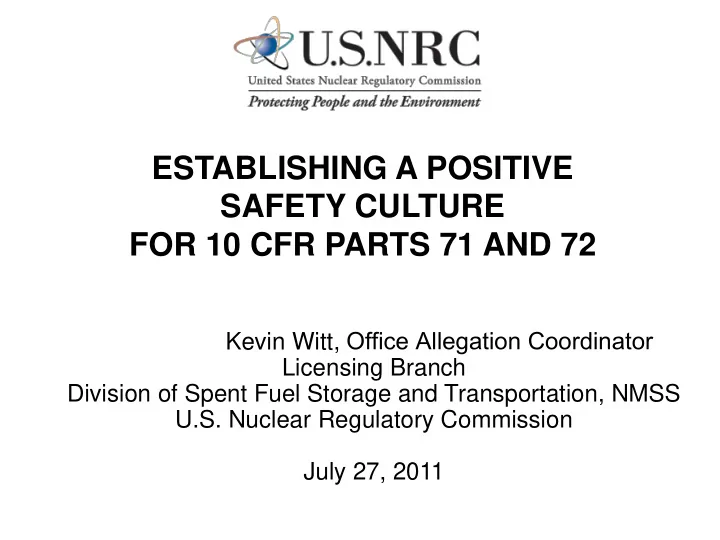

ESTABLISHING A POSITIVE SAFETY CULTURE FOR 10 CFR PARTS 71 AND 72 Office Allegation Coordinator Kevin Witt, Licensing Branch Division of Spent Fuel Storage and Transportation, NMSS U.S. Nuclear Regulatory Commission July 27, 2011
Presentation Outline • Safety Culture Background • Commission Direction • Areas of Consideration • Discussion Questions 2
Importance of Safety Culture • Operating experience has demonstrated nexus with safety culture and events • Safety culture contributes to the safe and secure use of radioactive materials • NRC, as the regulator, considers the importance of safety culture in its oversight programs and activities • Examples of safety culture 3
Statement of Policy (76 FRN 34773) Sets forth the Commission’s expectation that individuals and organizations performing regulated activities establish and maintain a positive safety culture commensurate with the safety and security significance of their activities and the nature and complexity of their organizations and functions 4
Safety Culture Traits • Leadership Safety Values and Actions • Problem Identification and Resolution • Personal Accountability • Work Processes • Continuous Learning • Environment for Raising Concerns • Effective Safety Communications • Respectful Work Environment • Questioning Attitude 5
Commission Direction • Commission direction is to “communicate and educate” • Implementation activities require prior Commission review and approval 6
“Leadership” Trait Exercise Example of Tier 3 Leadership Safety Values and Actions Tier 2 Leaders demonstrate a commitment to safety in their decisions and behaviors • Management in the field enforcing standards • Commitment to maintaining equipment • Resolves conflict • Actions match words • Incentives used to reinforce Tier 3 desired positive nuclear safety These Tier 3 behaviors were developed behaviors through an “affinity diagraming” exercise • Respects differing opinions by external stakeholders at an NRC- • Schedules are realistic and do sponsored public workshop in February not challenge safety standards 2010. They are provided as an example of how behaviors could be developed and do not constitute an all-inclusive or NRC-endorsed listing. 7
Areas of Consideration • Discussing the SCPS with licensee/certificate holder senior management and workers • Evaluating the effective use of corrective action programs through quality assurance program reviews • Considering and incorporating safety culture into inspection programs 8
Areas of Consideration, cont’d • Revising the NRC qualification programs to include specific training on safety culture • Evaluating how safety culture can be included in NRC staff guidance such as standard review plans 9
Discussion Questions • How can safety culture be integrated into NRC regulatory programs? • How can we increase attention to safety culture? • What can we do to better define safety culture as applied to Part 71/72 activities? • What are the potential pros and cons of placing more emphasis on safety culture? 10
References • February 2008 SRM-COMGBJ-08-0001 (initiated SCPS); Accession # ML102500672 • COMSECY-10-0007 (Project Plan for the Regulatory Program Review to Support Extended Storage and Transportation of Spent Nuclear Fuel); Accession # ML101390413 • March 2011 SECY-11-0005 (Proposed Final Safety Culture Policy Statement); Accession # ML103200087 • NRC safety culture website: http://www.nrc.gov/about- nrc/regulatory/enforcement/safety-culture.html 11
Contact • Steve Ruffin – steve.ruffin@nrc.gov • Kevin Witt – kevin.witt@nrc.gov 12
Safety Culture Traits, detailed Leadership Safety Values Problem Identification and Personal Accountability and Actions Resolution Issues potentially impacting safety are promptly identified, fully Leaders demonstrate a evaluated, and promptly All individuals take personal commitment to safety in their addressed and corrected responsibility for safety decisions and behaviors commensurate with their significance Environment for Raising Work Processes Continuous Learning Concerns A safety conscious work The process of planning and environment is maintained where Opportunities to learn about ways controlling work activities is personnel feel free to raise safety to ensure safety are sought out implemented so that safety is concerns without fear of and implemented maintained retaliation, intimidation, harassment or discrimination Effective Safety Respectful Work Environment Questioning Attitude Communications Individuals avoid complacency and continually challenge existing Communications maintain a focus Trust and respect permeate the conditions and activities in order on safety organization to identify discrepancies that might result in error or 13 inappropriate action
Recommend
More recommend